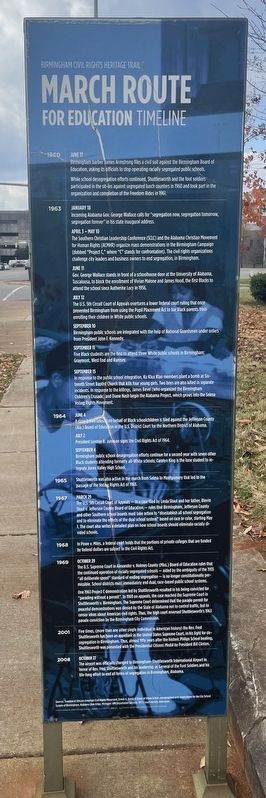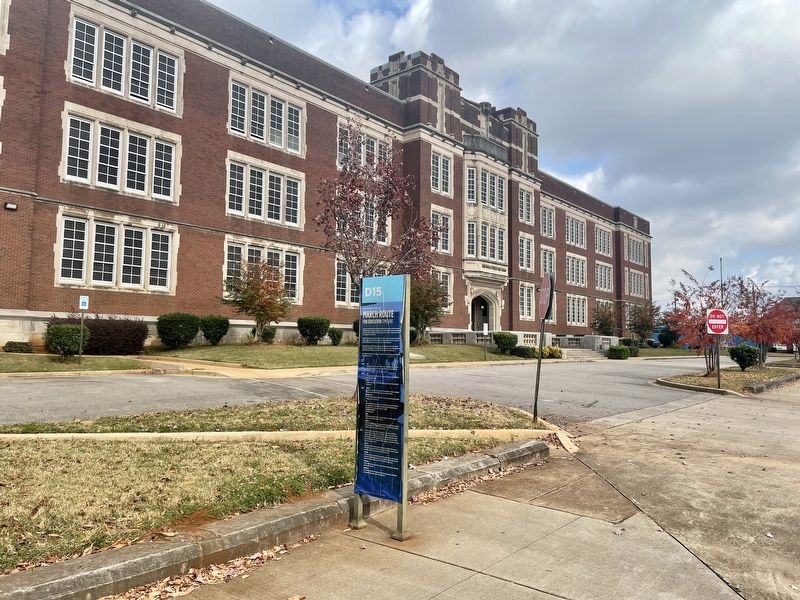Birmingham in Jefferson County, Alabama — The American South (East South Central)
March Route for Education Timeline
March Route for Education
— Birmingham Civil Rights Heritage Trail —
In many ways, the 1954 Brown v. Board of Education decision fueled the modern Civil Rights Movement. The NAACP's legal team strategically chipped away at the “separate but equal" doctrine to end segregated public schools. This victory launched a 10-year struggle by African Americans to remove all traces of Jim Crow segregation in the United States.
Many Southern school boards refused to follow either the letter or the spirit of the high court's 1954 Brown ruling and resisted all serious attempts to desegregate racially divided public schools. Some even shut down their White public schools for a decade or more rather than integrate them.
Only under court orders did these school boards begin to admit Black students to formerly all-White public schools. Though integration in Birmingham began in 1965, it took a series of additional lawsuits and desegregation plans for the city school board to fully end its racially divided school system.
The struggle for civil and human rights against all forms of fear, anger and oppression still continues for many Americans to this day.
1954
May 17
The Supreme Court rules against the Plessy v. Ferguson "separate but equal" doctrine in Brown v. Board of Education of Topeka, Kansas, thus paving the way for public school integration.
1955
May 31
The Supreme Court rules in "Brown II” that desegregation must occur with “all deliberate speed" but not immediately.
June 29
The NAACP wins a Supreme Court decision that orders the University of Alabama to admit Autherine Lucy.
1956
February 3
Autherine Lucy is admitted to the University of Alabama. Whites riot, and she is suspended. Later, she is expelled for taking further legal action against the university.
February/March
The Southern Manifesto, opposing integration of schools, is created and signed by all southern members of the U.S. Congress.
May
When the State of Alabama formally stopped the NAACP from organizing within the state, Rev. Fred Shuttlesworth helped establish the Alabama Christian Movement for Human Rights (ACMHR) to take up the work once done by the NAACP.
Other Downtown Stores
8 arrested for picketing
August
The Alabama State Legislature drafts the Pupil Placement Act, which allows parents to "choose" which schools their children will attend.
December
when the United States Supreme Court ruled that bus segregation in Montgomery, Alabama was unconstitutional, Rev. Fred Shuttlesworth announced that the ACMHR would challenge segregation laws in Birmingham
on December 26, 1956.
1957
In 1957 Rev. Shụttlesworth with Dr. Martin Luther King, Jr., Rev. Ralph Abernathy, Rev. Joseph Lowery, Rev. T.J. Jemison, Rev. C.K. Steele, Rev. A.L Davis, Bayard Rustin and Ella Baker helped form the Southern Leadership Conference on Transportation and Nonviolent Integration, Later renamed the Southern Christian Leadership Conference. The SCLC motto underscored its commitment to nonviolent desegregation actions: "Not one hair of one head of one person should be harmed."
August 21
Rev. Fred Shuttlesworth and other parents including James Armstrong, Wathaw Avery Sr. and Mrs. Annie L. Horton, petition the Birmingham Board of Education to allow their children to attend the closest school to their homes without regard to race.
President Dwight Eisenhower federalizes the National Guard and orders U.S. Army troops to ensure Little Rock Central High School in Arkansas is integrated. Federal and National Guard troops escort the Black students, called the “Little Rock Nine,” into the school.
September 9
Rev. Fred Shuttlesworth tries to enroll his children at Phillips High School but is attacked by a mob in front of the school.
December 18
Rev. Fred Shuttlesworth files the first lawsuit against the Birmingham Board of Education over segregated public schools.
The case is later dismissed.
1960
June 17
Birmingham barber James Armstrong files a civil suit against the Birmingham Board of Education, asking its officials to stop operating racially segregated public schools.
While school desegregation efforts continued, Shuttlesworth and the foot soldiers participated in the sit-ins against segregated lunch counters in 1960 and took part in the organization and completion of the Freedom Rides in 1961.
1963
January 18
Incoming Alabama Gov. George Wallace calls for "segregation now, segregation tomorrow, segregation forever" in his state inaugural address.
April 3 - May 10
The Southern Christian Leadership Conference (SCLC) and the Alabama Christian Movement for Human Rights (ACMHR) organize mass demonstrations in the Birmingham Campaign (dubbed “Project C," where “C” stands for confrontation). The civil rights organizations challenge city leaders and business owners to end segregation, in Birmingham.
June 11
Gov. George Wallace stands in front of a schoolhouse door at the University of Alabama, Tuscaloosa, to block the enrollment of Vivian Malone and James Hood, the first Blacks to attend the school since Autherine Lucy in 1956.
July 12
The U.S. 5th Circuit Court of Appeals overturns a lower federal court ruling that once prevented Birmingham from using the Pupil Placement Act to bar Black parents from enrolling their children in White public schools.
September 10
Birmingham public schools are integrated with the help of National Guardsmen under orders from President John F. Kennedy.
September 11
Five Black students are the first to attend three White public schools in Birmingham: Graymont, West End and Ramsey.
September 15
In response to the public school integration, Ku Klux Klan members plant a bomb at Sixteenth Street Baptist Church that kills four young girls. Two boys are also killed in separate incidents. In response to the killings, James Bevel (who organized the Birmingham Children's Crusade) and Diane Nash begin the Alabama Project, which grows into the Selma Voting Rights Movement.
1964
June 4
A segregation lawsuit on behalf of Black schoolchildren is filed against the Jefferson County (Ala.) Board of Education in the U.S. District Court for the Northern District of Alabama.
July 2
President Lyndon B. Johnson signs the Civil Rights Act of 1964.
September 4
Birmingham public school desegregation efforts continue for a second year with seven other Black students attending formerly all-White schools; Carolyn King is the lone student to integrate Jones Valley High School.
1965
Shuttlesworth was also active in the march from Selma to Montgomery that led to the passage of the Voting Rights Act of 1965.
1967
March 29
The U.S. 5th Circuit Court of Appeals - in a case filed by Linda Stout and her father, Blevin Stout v. Jefferson County Board of Education, – rules that Birmingham, Jefferson County and other Southern school boards must take action to “disestablish all school segregation and to eliminate the effects of the dual school system" based on race or color, starting May 1. The court also writes a detailed plan on how school boards should eliminate racially divided schools.
1968
In Powe v. Miles, a federal court holds that the portions of private colleges that are funded by federal dollars are subject to the Civil Rights Act.
1969
October 29
The U.S. Supreme Court in Alexander v. Holmes County (Miss.) Board of Education rules that the continued operation of racially segregated schools – aided by the ambiguity of the 1955 "all deliberate speed” standard of ending segregation – is no longer constitutionally permissible. School districts must immediately end dual, race-based public school systems.
One 1963 Project ( demonstration led by Shuttlesworth resulted in his being convicted for "parading without a permit”. In 1969 on appeals, the case reached the Supreme Court in Shuttlesworth v. Birmingham. The Supreme Court determined that the parade permit for peaceful demonstrations was denied by the State of Alabama not to control traffic, but to censor ideas about American civil rights. Thus, the high court reversed Shuttlesworth's 1963 parade conviction by the Birmingham City Commission.
2001
Five times, (more than any other single individual in American history) the Rev. Fred Shuttlesworth has been an appellant in the United States Supreme Court, in his fight for desegregation in Birmingham. Thus, almost fifty years after the historic Philips School beating, Shuttlesworth was presented with the Presidential Citizens Medal by President Bill Clinton.
2008
October 27
The airport was officially changed to Birmingham-Shuttlesworth International Airport in honor of Rev. Fred Shuttlesworth and his leadership as General of the Foot Soldiers and his life-long effort to end all forms of segregation in Birmingham, Alabama.
Sources: Timeline of African-American Civil Rights Movement, Ernest A. Hardy, A Study of Urban School Desegregation with Implications for the City School System of Birmingham, Alabama (Ann Arbor, Michigan: UMI Dissertation Services, 1977); court records, interviews
Erected by the Birmingham Civil Rights Heritage Trail. (Marker Number D15.)
Topics and series. This historical marker is listed in these topic lists: African Americans • Civil Rights. In addition, it is included in the Birmingham Civil Rights Heritage Trail series list. A significant historical date for this entry is January 18, 1954.
Location. 33° 31.357′ N, 86° 48.319′ W. Marker is in Birmingham, Alabama, in Jefferson County. Marker is on 7th Avenue North west of 24th Street North, on the right when traveling west. Located in front of John Herbert Phillips Academy. Touch for map. Marker is in this post office area: Birmingham AL 35203, United States of America. Touch for directions.
Other nearby markers. At least 8 other markers are within walking distance of this marker. Historic Demonstration at Phillips School (a few steps from this marker); Desegregating Ramsay School (within shouting distance of this marker); Phillips High School (within shouting distance of this marker); Desegregating West End School (about 300 feet away, measured in a direct line); Integration Begins: Desegregating Graymont School (about 400 feet away); Southern Resistance (about 500 feet away); Children's Crusade for Education (about 500 feet away); School Integration Now (about 600 feet away). Touch for a list and map of all markers in Birmingham.
Regarding March Route for Education Timeline. The Civil Rights Activist Committee “Home of the Foot Soldiers“ is the Information Center for the Birmingham Civil Rights Heritage Trail.
Credits. This page was last revised on January 8, 2022. It was originally submitted on December 13, 2021, by Mark Hilton of Montgomery, Alabama. This page has been viewed 324 times since then and 40 times this year. Photos: 1, 2, 3. submitted on December 13, 2021, by Mark Hilton of Montgomery, Alabama.


